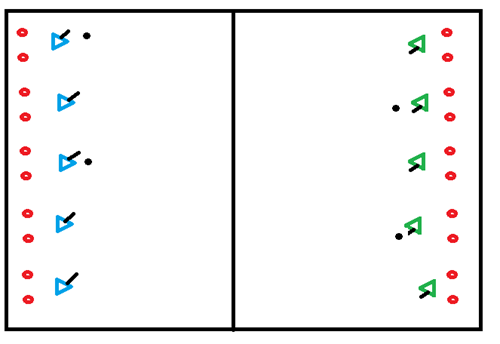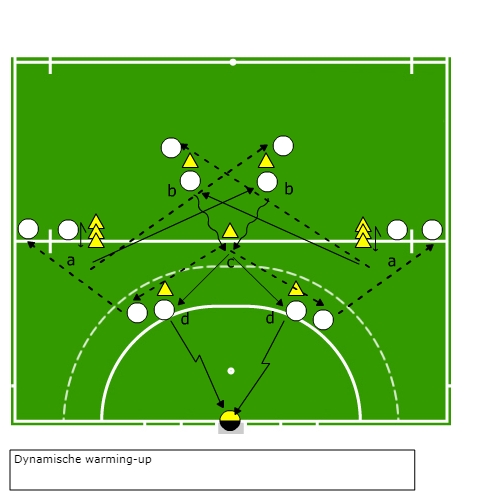Hockey drills for technique passing
- Orange 1 passes to Blue 2.
- Blue 2, 3, 4 try to score in the 2 little goals on the back line.
- Orange 1 tries to get in possession of the ball by defending on its strong side (fh). If he succeeds, he can score in the goal on the middle line (1½ meter wide).
- The exercise is started again when:
- Blue scores in 1 of the 2 goals on the back line at Orange.
- Orange 1 scores in the conversion in the goal of Blue.
- The ball goes over the back line.
Tips Ball possession
- Threaten with the ball and speed towards the goal.
- Look at each other as attackers when offering the ball.
- Help the ball carrier by running away from the ball.
Tips on no ball possession
- Guide with stick on the ground, forehand at ball height.
- Stay out of the ball carrier's physical space.
- Keep the ball on your forehand side. or v2 to create a 1:2 situation (double).
Passing tips
- At loss of possession: Pressure the ball immediately, cut off the shortest path to the goal.
goal.
- When gaining the ball: Keep the ball in quick action/goal attempt towards the goal.
Make it more difficult
- Use 1 goal instead of 2.
- Vary the tackling.
Goal: Build up by moving the ball.
Instruction:
- 1 starts with the ball and plays it to 2
- 2 plays the ball back to 1
- 1 plays the ball to 3
- 3 plays the ball to 4
- 4 starts the attack and may choose how he does this
Point of attention: The defenders try to get rid of the ball as quickly and skillfully as possible
- 2 equal teams, or in case of odd numbers with a joker,
- try to keep the players on the team for as long as possible.
- This can be done through short replay, the duel and then replay.
- Two teams with substitutes, substitutions are made when a goal is scored.
- Each person defends a goal, on each field there are 5 goals,
- so there are also 5 people who defend these goals.
- If a goal is scored in your goal, you have to sit on the sidelines and you become a substitute.
- A new player (substitute) from the side enters the field and will defend the goal.
- If a goal is scored, it is 1 point.
- The team that has the most points at the end of the game is the winner.

- 2 pawns face each other,
- at a random distance (depends on whether you want to push or flatten, for example).
- Player 1 and 3 stand with pawn A.
- Player 2 stands at pawn B.
- 1 plays the ball to player 2,
- 2 receives the ball.
- After player 1 passes the ball, he runs after his ball towards pion B.
- When player 2 has passed again he runs in the direction of pion A.
- etc. etcde
- You can play this exercise with minimum 3 players, maximum 5 otherwise the intensity will be very low.
Overplaying to score
- Two players continuously play the ball over
- until one of them is so close to the goal
- that he can score in the goal.
Variation 2-1 situation:
- Under pressure from the defender, the attackers must now play together and try to score.
- The defender can score a point by conquering the ball and then dribbling over the dead ball line.
- This is the short side without a goal.
Goal
- To practise running through the ball in motion (accepting in the run).
Set up
- 2 players stand in a line (e.g. sideline)
- and 1 player stands 10-20 metres away.
- The first player of the team runs a few metres and then passes the ball to the second player.
- and passes the ball to the person standing alone.
- He starts running roughly at the time of the pass.
- This way, he runs through the ball at the moment he takes over.
- The person who passed then moves to the 1-ling position
- The exercise can be made more difficult by lengthening the distance between passes In addition, a passing move can be made before the pass.
Goal
- To regain that ball feeling and get back into the swing of things.
Set up
- The players form pairs
- and they stand opposite each other on a few meters (5 for example).
- Then they start pushing each other.
- At a certain moment, they take some more distance and start flattening.
- A plays the ball to the incoming B
- B rebounds the ball
- A drives a little
- B offers himself wide and A plays the ball into the space to B
- Because of B's running action outside, C makes space by running inside.
- B accelerates during his running action with the ball over the back line.
- C has gone towards the dot
- B passes, C rounds off (one-touch).
Variation: Exercise 2x.
Start with a three-run.
- A floats with the ball, when A is halfway, he pushes the ball out of the run to B.
- B does the same (to C)
- etc.
- Apply differentiation.
Possibly after this warm-up play another game of possession.
Purpose
: To get warm through a combination of passing, running, and picking up in the run and from standstill.
Format
:This exercise is also known from volleyball. The pawns are not exactly in a triangle. It is possible, depending on the number of players, to set up a multiple of the exercise.
- The player at A passes the ball straight to the player at B.
- The player at B plays the ball to the player at C and runs towards point A.
- The player at C receives the ball at point D and passes it to point A.
- For the changeover, A runs to B, B via D to C and C to A.

Variations:
- Variations can be made in terms of stroke. (hit, push, flats)
- The distances can be made larger or smaller to adjust the level of difficulty.
- Pawns can be placed to play in between. This is to increase the purity. When you make the cones smaller, the degree of difficulty increases.
- To play the ball from C to D there can be bounced.
- To play the ball from D to A you can play bounce.
- You can also place point C on the other side so that you reverse backhand and forehand.
- When you place point C at 90 degrees from point B, you can do the same exercise, only then you will hit point D from a different angle.
- When you set up different situations, you can rotate the exercise. Situation A is the standard, in situation B the exercise is mirrored, in situation C the exercise is set up so that point B and C are at 90 degrees from each other and situation D is a mirror of situation C.
Points of attention:
- As a trainer you can take a good look at the different techniques of your players.
- Sit low at the take-off.
- When playing the ball from C to D, the ball may not shoot too far in the direction of A. The intention is that the player coming from B should take the ball at right angles.
- Play the ball on the forehand where possible.
- Stand ready to receive the ball. (low to the ground, stick on the ground)
Purpose
: Various technical forms to warm up.
Format
:The exercise can be set up one-sided or two-sided. This depends on the number of players in the training.
- At point A, the player makes a drag and passes the pawns. Then he passes to the player at point B.
- The player at point B takes the ball and dribbles to point C. From there he passes to the player at point C.
- The player receives the ball and turns towards the goal, completing the pass
- Before turning, you run after the ball. Point D rejoins point A again.

Variations:
- You can set up the exercise single-sided and double-sided.
- You can also choose to warm up the goalkeeper in this way.
- At C, you can switch sides. If you are coming from the right, play the ball to the right, so that you can practise from both sides.
Points of attention:
- This is a good time to look at different techniques of your players and polish them.
- When turning and dribbling, the ball must stay on the stick.
- There is only one point at C, so players should not get in each other's way and look for the next ball to enter play.
- All balls are played into the forehand of the teammates.







